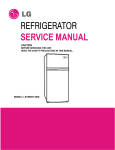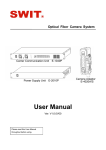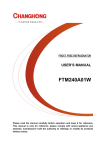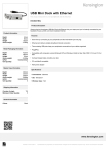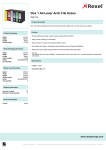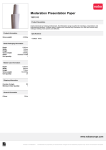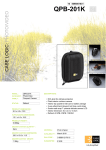Download Changhong Electric FTM530R02W User`s manual
Transcript
FROST FREE REFRIGERATOR USER’S MANUAL FTM531R02S FTM530R02W Please read the manual carefully before operation and keep it for reference. NAMES OF THE PARTS 1. FREEZER SHELVES 2. ICE CUBE TRAY 3. FREEZER TEMPERATURE CONTROL 4. REFRIGERATOR TEMPERATURE CONTROL 5. REFROGERATOR SHELVES 6. LED LAMP 7. CRISPER COVER 8. CRISPER 9. FREEZER DOOR RACK 10. REFRIGERATOR DOOR UPPER RACK 11. REFRIGERATOR DOOR MIDDLE RACK 12. REFRIGERATOR DOOR BOTTOM RACK WARNING: Never touch the interior of the Freezer or frozen foods in the compartment with wet hands as this could result in frost bite. 1 IMPORTANT SAFETY INSTRUCTIONS WARNING To reduce the risk of fire, electrical shock, or injury when using your refrigerator, follow these basic precautions: Read all instructions before using the refrigerator. DANGER or WARNING: Risk of child entrapment. To avoid the possibility of child entrapment, please take the following precautions before throwing out the refrigerator. - Remove all doors from the unit. - Leave the shelves in place so that children may not easily climb inside. Never allow children to operate, play with, or crawl inside the refrigerator. Never clean refrigerator parts with flammable fluids. The fumes can create a fire hazard or explosion. Do not store or use gasoline or any other flammable vapors and liquids in the vicinity of this or any other refrigerator. The fumes can create a fire hazard or an explosion. - Please read and save these instructions - ELECTRICAL REQUIREMENTS This appliance must be grounded. In the event of electrical short circuit, grounding reduces the risk of electrical shock by providing an escape wire for the electrical current. This appliance is equipped with a cord having a grounding wire with a grounding plug. The plug must be plugged into an outlet that is properly installed and grounded. Please make sure the power socket has been fitted by a qualified electrician and the ground wire has been connected properly. They all meet the standards of the Australia Electrical Standards. WARNING: An empty refrigerator can pose a threat to children. To render the unit harmless we strongly recommend removing the door prior to disposal. DANGER: Risk of child entrapment.(Before you throw away your old refrigerator or freezer.) ·Take off the doors ·Leave the shelves in place so that children may not easily climb inside. WARNING: Improper use of the grounding plug can result in a risk of electric shock. Consult a qualified electrician or serviceman if the grounding instructions are not completely understood or if doubt exists as to whether the appliance is properly grounded. DO NOT USE AN EXTENSION CORD Use an exclusive wall outlet. Do not connect your refrigerator to extension cords or together with any other appliance in the same wall outlet. 2 R600A WARNINGS NOTE: This model uses 0.068Kg of R600A flammable refrigerant in its sealed system. The following must be observed for your safety: R600A Refrigerant Warning • This appliance contains a small quantity of R600A refrigerant which is environmentally friendly, but flammable. It does not damage the ozone layer, nor does it increase the greenhouse effect. • During transportation and installation, ensure that the tubing of the refrigerant circuit is not damaged. • Leaking refrigerant can ignite and may damage the eyes. • In the event any damage does occur, avoid exposure to open fires and any device which creates a spark. Disconnect the appliance from the mains power. • Thoroughly ventilate the room in which the appliance is located for several minutes. • Notify Customer Service for necessary action and advice. • The room for installing the appliance must be at least 1 cubic metre per 8 grams of refrigerant. The refrigerant quantity contained in this appliance is listed above in grams; it is also noted on the Rating Plate of the appliance. It is hazardous for anyone other than an Authorized Service Person to carry out servicing or repairs to this appliance. In Queensland the authorized person must hold a Gas Work Authorization for hydrocarbon refrigerants, before carrying out servicing or repairs which involve the removal of covers. WARNNING 1. Keep ventilation openings, in the appliance enclosure or in the built-in structure, clear of obstruction. 2. Do not use mechanical devices or other means to accelerate the defrosting process, other than those recommended by the manufacturer. 3. Do not damage the refrigerant circuit. 4. Do not use electrical appliances inside the food storage compartments of the appliance, unless they are of the type recommended by the manufacturer. 5. Do not store explosive substances such as aerosol cans with a flammable propellant in the appliance. 6. If the supply cord is damaged, it must be replaced by the manufacturer, its service agent or similarly qualified persons in order to avoid a hazard. The environment and personal safety must be considered when disposing of this appliance. Please ensure the appliance is taken to a recycle center for safe recycling. DO NOT dispose of the appliance in land fill as the insulation and refrigerant gas contained in these appliances are flammable. 3 INSTALLATION INSTRUCTIONS Before Using Your Refrigerator Remove the exterior and interior packing. Before connecting the refrigerator to the power source, let it stand upright for approximately 4 hours. This will reduce the possibility of a malfunction in the cooling system from improper handling during transportation. Clean the interior surface with lukewarm water using a soft cloth. Take off all plastic protection cover around the cabinet for better heat exchange on the surface. Installing Your Refrigerator This appliance is designed to be free standing only, and should not be recessed or built-in. Place your refrigerator on a floor that is strong enough to support the refrigerator when it is fully loaded. Allow 5 inches of space between the back and sides of the refrigerator, which allows the proper air ventilation. Adjust the feet to keep the refrigerator level. Locate the refrigerator away from direct sunlight and sources of heat (stove, heater, radiator, etc.). Direct sunlight may affect the acrylic coating and heat sources may increase electrical consumption. Ambient temperature below 50°F or above 85°F will hinder the performance of this appliance. This unit is not designed for use in a garage or any other outside installation. Avoid locating the refrigerator in moist areas. Plug the refrigerator into dedicated, properly installed-grounded wall outlet. Do not under any circumstances cut or remove the third (ground) prong from the power cord. Any questions concerning power and/or grounding should be directed toward a certified electrician or an authorized service center. This unit is not designed to be installed in a caravan or used with an inverter. After plugging the appliance into a wall outlet, turn the unit on and allow the unit to cool down for 2~3 hours before placing food in the refrigerator or freezer compartment. 4 Door handle installation Freezer door handle Refrigerator door handle Please match up the plastic clips on the door to the slots on the door handle. Once the door handle is in place(attach to the door with no gap), gently push downwards until handle click into the correct position. Installing both door handles by the same method. Note: The door handle cannot be reversed. 5 OPERATING Temperature Control Your refrigerator has a separate control for regulating the temperature for each section independently. For the first time you turn the unit on, adjust the temperature control knobs to “COLDER” in both freezer and refrigerator sections and run for at least 2 hours before putting foods inside. This will ensure the cabinet is thoroughly chilled before your food is stored. The range of the temperature control is from position "COLD" the warmest to "COLDER " the coldest. After refrigerator operated for 24 hours, please set the temperature control to mid-point(between COLD and COLDER). Then Adjust the temperature control to the setting that best suits your needs. NOTE: If the unit is unplugged, loses power; you must wait 3 to 5 minutes before restarting the unit. If you attempt to restart before this time delay, the refrigerator will not start. Large amounts of food will lower the cooling efficiency of the appliance. Do not place the foods on the air outlet, and leave spaces for airflow. Do not store can foods or food stored in glass containers in the freezer compartment. The exterior refrigerator walls might be warmer than room temperature. This is normal while the compressor works to transfer heat from inside the refrigerator to outside via cabinet surface. ICE CUBE TRAY To make ice, pull the ice tray out, pour cool water into the trays until the water reaches to 3/4 high position of trays, then pull the cube in again. To shorten the time of making ice, you can set the temperature control knob at the position “colder”. Waiting for about 3 hours, gently twist the ice tray knob, and the ice cubes will drop into the ice storage box, pull out the box and get the ice cubes. 6 CARE AND MAINTENANCE Cleaning Your Refrigerator Upon installation of your new appliance, it is recommended that it be cleaned thoroughly. Turn off the refrigerator first and then unplug the unit from the wall outlet. Remove all food content. Wash the inside with a damp warm cloth soaked in lukewarm water and baking soda solution. The solution should be about 2 tablespoons of baking soda to a quart of water. Be sure to keep the door gasket (seal) clean to keep the unit running efficiently. The outside of the refrigerator should be cleaned with mild detergent and warm water. Dry the interior and exterior with a soft cloth. The condenser coils should be vacuumed when they are dusty or dirty. Vacation Time Turn off the refrigerator first and then unplug the unit from the wall outlet. Remove all the food. Clean the refrigerator. Leave the lid open slightly to avoid possible formation of condensation, mold, or odors. Use extreme caution in the case of children. The unit should not be accessible to child’s play. Short vacations: Leave the refrigerator operating during vacations of less than three weeks. Long vacations: If the appliance will not be used for several months, remove all food and unplug the power cord. Clean and dry the interior thoroughly. To prevent odor and mold growth, leave the door open slightly: blocking it open if necessary or have the door removed. Moving Your Refrigerator Turn off the refrigerator first and then unplug the unit from the wall outlet. Remove all the food and drinks. Securely tape down all loose items inside your refrigerator. Tape the doors shut. Be sure the refrigerator stays in the upright position during transportation. 7 Energy Saving Tips The refrigerator should be located in the coolest area of the room, away from heat producing appliances or heating ducts, and out of the direct sunlight. Let hot foods cool to room temperature before placing in the refrigerator. Overloading the refrigerator forces the compressor to work harder. Foods that freeze too slowly may lose quality, or spoil. Be sure to wrap foods properly, and wipe containers dry before placing them in the refrigerator. This cuts down on frost build-up inside the refrigerator. Organize and label food to reduce door openings and extended searches. Remove as many items as needed at one time, and close the door as soon as possible. TROUBLESHOOTING GUIDE You can solve many common refrigerator problems easily, saving you the cost of a possible service call. Try the suggestions below to see if you can solve the problem before calling for service. PROBLEM Refrigerator does not operate. Compressor turns on and off frequently. 8 POSSIBLE CAUSE Fridge isn’t plugged in. The circuit breaker tripped or a blown fuse. The room temperature is hotter than normal. A large amount of food has been added to the refrigerator. The door is opened too often. The door is not closed completely. The temperature control is not set correctly. The door gasket does not seal properly. The refrigerator does not have the correct clearances. The refrigerator has recently been disconnected for a period of time. 4 hours are required for the refrigerator to cool down completely. Temperature inside the refrigerator is too warm. Temperature inside the refrigerator is too cold. Temperature of surface is warm. external Popping or cracking compressor comes on. refrigerator sound when Bubbling or gurgling sound, like water boiling. Vibrations. Moisture forms on inside refrigerator walls. Moisture forms on outside of refrigerator. The door will not close properly. Temperature control is set too warm. Turn the control to a cooler setting and allow several hours for the temperature to stabilize. Door is kept open too long or is opened too frequently. Warm air enters the refrigerator every time the door is opened. Open the door less often. The door is not closed completely. The door gasket does not seal properly. A large amount of warm or hot food might have been stored recently. Wait until the refrigerator has had a chance to reach its selected temperature. The refrigerator has recently been disconnected for a period of time. 4 hours is required for the refrigerator to cool down completely. Temperature control is set too cold. Turn the control to a warmer setting and allow several hours for the temperature to stabilize. The exterior refrigerator walls can be as much as 30F warmer than room temperature. This is normal while the compressor works to transfer heat from inside the refrigerator to outside via cabinet surface. Metal parts undergo expansion and contraction, as in hot water pipes. This is normal. Sound will level off or disappear as refrigerator continues to run. Refrigerant (used to cool refrigerator) is circulating throughout the system. This is normal. Check the refrigerator is on a level surface. Floor is uneven or weak. Refrigerator rocks on the floor when it is moved slightly. Be sure floor can adequately support refrigerator. Level the refrigerator by putting wood or metal shims under part of the refrigerator. The refrigerator is touching the wall. Re-level the refrigerator and move it from the wall. See “Installation Instructions”. Weather is hot and humid, which increases internal rate of frost build-up. This is normal. Door is slightly open. Door is kept open too long, or is opened too frequently. Open the door less often. The door is not sealed properly. Door is slightly open, causing cold air from inside the refrigerator to meet warm moist air from outside. The refrigerator is not on a level surface. The gasket is dirty. The storage basket is out of position. Any other enquiry, please call our service centre as: 1300 796 688. Changhong Electric (AUST) Pty Ltd 2/251 Ferntree Gully Rd, Mt Waverley VIC 3149 www.changhong.com.au 9 10












